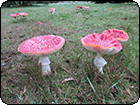How do you give directions? Do you use road names or landmarks?
→[More:]I like to do this little experiment where I'll ask different people, "Where's Yardley?" And the answer almost always differs according to their gender. Females will say, "Bucks County. Near Doylestown." Males will say, "Well, you go down Rt.611..."
And the route name people, be they male or female,have an almost compulsive need to finish the full directions. Even if you tell them, repeatedly, that you're not familiar with those roads or just not interested in hearing detailed directions.
"We went to dinner last night at Big Restaurant."
"Oh? Where's that?"
"Well you take Maple St. to Oak Road..."
"I'm really bad with road names. What's the restaurant near?"
"It's not near anything. You take Maple to Oak.."
"Well, what town is it in?"
"It's in Big Town. You make a left onto Oak."
"Oh. I'm not familiar with Big Town. I don't know where Oak St. is. But anyway, was it good?"
"Well, it's not actually on Oak. You take Oak to Main and go through the turnabout-you'll want to stay to the right-get off on Bee St. and the restaurant is on your right."
Do you do this? Why?
 photo by splunge
photo by splunge
 photo by TheophileEscargot
photo by TheophileEscargot
 photo by Kronos_to_Earth
photo by Kronos_to_Earth
 photo by ethylene
photo by ethylene